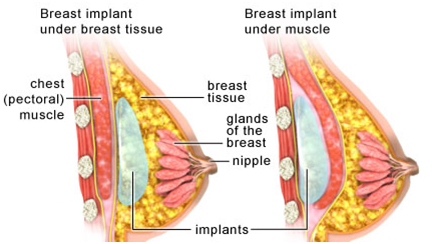
Breastfeeding after Breast or Nipple Surgery
Can a woman who has had breast or nipple surgery breastfeed her baby?
Yes. New mothers who have had previous breast or nipple surgery can breastfeed their newborns and are strongly encouraged to do so. All postpartum women can produce at least droplets of colostrum (first milk). Even if mothers get only some milk, they are providing their baby with antibodies at every feeding.
However, each woman is different. In some women, the milk supply might not be affected at all. These new moms can produce the full amount of milk. Other women may produce less breast milk. Before the baby is born, it is not possible to know how much milk can be produced. Caregivers should be aware of a woman’s surgical history so that they can help her keep track of a new mom’s milk supply.
According to La Leche League, a woman seems to have a better milk supply when her surgery occurred five or more years before she became pregnant. This is true regardless of the type of surgery performed.
What types of surgery can affect the production of breast milk?
The supply of breast milk mainly is affected by a surgery’s cutting of milk ducts and nerves in the breast. Breast reduction surgery tends to have the greatest potential effect on milk supply. Breast augmentation surgery (increasing the size of the breast), lift, nipple, and diagnostic surgeries also can cause a woman to produce less milk. Milk supply is less affected if the nipple and areola remain attached to the breast during surgery. The location and the length and depth of the surgery’s incision can be a factor in how much milk production will be affected.
What can a new mother who has had breast or nipple surgery do to increase production of breast milk?
The key to increasing breast milk production is getting as much milk as possible out of the breast in the first two weeks. There is no pump as effective as a well latched, vigorous baby. Breasts will have more milk production if more milk is removed. In the first two to three weeks, the body determines how much breast milk is needed.
The most effective way to remove milk, other than breastfeeding, in the first three days is for the mom to do manual expression. Once milk is established, then milk can be removed by manual expression and pumping. Mothers should express or pump following each feeding, or instead of a feeding, if baby will not latch after each feeding for the first 10 days after delivery.
Breast emptying is an important factor in increasing milk supply, but the baby at the breast is most effective. Other methods include breast compression, relaxation techniques, and using herbal and prescription medicines that increase milk production (galactagogues).
How can a nursing mother supplement breastfeeding?
You can feed your baby expressed milk or formula, if needed. Supplemental nursing systems use tube feeding to help supplement milk from the breast. The system is made up of a container that has supplemental liquid. A tube runs from the container to the nipple of the breast, allowing the baby to suck on the nipple and the tube at the same time. Ask your Lactation Consultant for help with this.
How does a mother measure her success at breastfeeding?
There are many benefits to breastfeeding beyond breast milk production. Successful breastfeeding does not always mean producing a full supply of milk. Some mothers find it possible to have breast milk be the baby’s only nutrition. Others, however, may need the baby’s entire nutrition to come from supplements.
Nurturing your baby at the breast can be fulfilling, even with the use of a supplemental feeding device. New mothers know that every drop of breast milk counts. Mothers value the time that the baby is skin-on-skin with them. This time is important even if the baby is not getting nutrition from sucking.
Can a woman who has had nipple piercing breastfeed her baby?
Consider removing nipple jewelry in the second trimester of pregnancy, and leave the jewelry off during the period of time you nurse your baby. If you choose to wear nipple jewelry, it must be removed prior to breastfeeding due to a risk of infant choking. A recent piercing may not be healed completely. Mom should be alert to signs of infection as well as scarring that can cause plugged nipple pores while breastfeeding. When an infant nurses, milk may come from the pierced sites.

Để lại một phản hồi Hủy